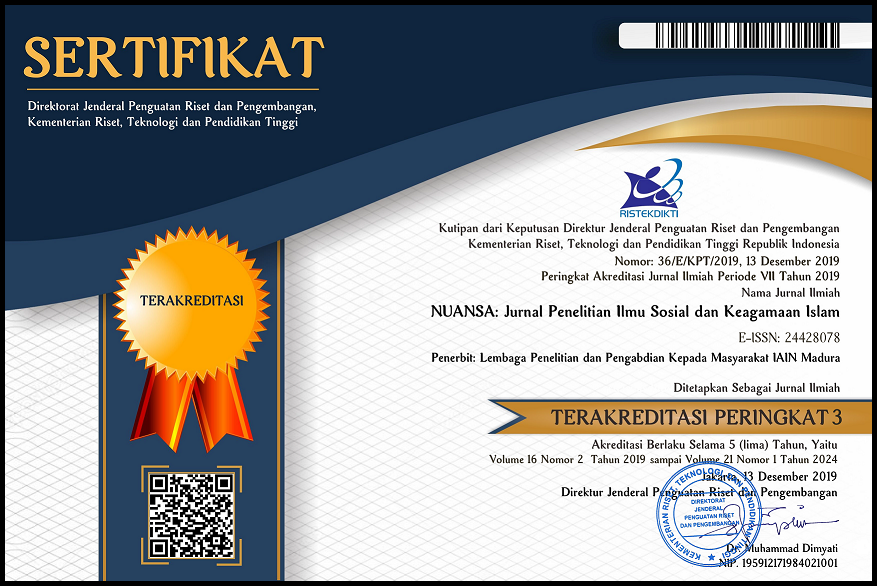Perlindungan Hukum Keris Aeng Tong-Tong Sumenep Dalam Hukum Nasional dan Konvensi Internasional
 Abstract views: 606
,
Abstract views: 606
,
 pdf downloads: 425
pdf downloads: 425
Abstract
Kris is an object of Indonesian culture which has beautiful artistic and high economic values. Kris making is still maintained in several areas, one of which is in Sumenep Regency. Since 2014, Sumenep Regency has been recognized by UNESCO as the area that has the most Mpu (makers of heirlooms) in the world and most of them are in Aeng Tong-Tong Village. The tradition of making kris in Sumenep has existed since the time of the Majapahit Kingdom and has continued to this day. The rapid development of the industry and the number of kris makers in Sumenep have made Sumenep the Indonesian Kris City. The aim of this research is to analyze the legal protection of the Aeng Tong-Tong Sumenep Kris based on national laws and international conventions using a statutory approach. The legal protection of the Aeng Tong-Tong Sumenep Kris in national law is contained in Law Number 28 of 2014 concerning Copyright and Law Number 5 of 2017 concerning the Promotion of Culture, while the legal protection of the Aeng Tong-Tong Sumenep Kris in International Conventions is contained in The Convention on the Protection and Promotion of the Diversity of Cultural Expressions 2005, The Convention for the Safeguarding of the Intangible Cultural Heritage 2003, and The Berne Convention for the Protection of Literary and Artistic Work. In realizing optimal legal protection for the Aeng Tong-Tong Sumenep Kris in national law and international conventions, a comprehensive legal protection must be provided including legal protection for Intellectual Property and Non-Intellectual Property.
(Keris merupakan benda hasil budaya bangsa Indonesia yang memiliki nilai seni yang indah dan nilai ekonomi yang tinggi. Pembuatan keris tetap dipertahankan di beberapa daerah, salah satunya di Kabupaten Sumenep. Sejak Tahun 2014, Kabupaten Sumenep diakui oleh UNESCO sebagai daerah yang memiliki Mpu (pembuat benda pusaka) terbanyak di dunia dan sebagian besar ada di Desa Aeng Tong-Tong. Tradisi pembuatan keris di Sumenep sudah ada sejak zaman Kerajaan Majapahit dan masih terus bertahan hingga kini. Pesatnya perkembangan industri dan jumlah perajin keris di Sumenep menjadikan Sumenep sebagai Kota Keris Indonesia. Tujuan pada penelitian ini untuk menganalisis perlindungan hukum Keris Aeng Tong-Tong Sumenep berdasarkan hukum nasional dan konvensi internasional dengan menggunakan pendekatan perundangan. Perlindungan hukum Keris Aeng Tong-Tong Sumenep dalam hukum nasional terdapat dalam UU Nomor 28 Tahun 2014 tentang Hak Cipta dan UU Nomor 5 Tahun 2017 tentang Pemajuan Kebudayaan, sedangkan perlindungan hukum Keris Aeng Tong-Tong Sumenep dalam Konvensi Internasional terdapat dalam The Convention on the Protection and Promotion of the Diversity of Cultural Expression 2005, The Convention for the Safeguarding of the lntangible Cultural Heritage 2003, dan The Berne Convention for the Protection of Literary and Artistic Work. Dalam mewujudkan perlindungan hukum yang optimal terhadap Keris Aeng Tong-Tong Sumenep dalam hukum nasional dan konvensi internasional, maka harus dilakukan perlindungan hukum secara menyeluruh meliputi perlindungan hukum atas Kekayaan Intelektual dan Non Kekayaan Intelektual.)
Downloads
References
Badan Penelitian dan Pengembangan HAM Kementerian Hukum dan HAM RI. Perlindungan Kekayaan Intelektual atas Pengetahuan Tradisional dan Ekspresi Budaya Tradisional Masyarakat Adat. Bandung: Alumni, 2013.
Berne Convention For The Protection of Literary And Artistic Works (1886).
Bustami, Simona. “Urgensi Pengaturan Ekspresi Budaya (Folklore) Masyarakat Adat.” Jurnal Hukum Prioris 2, no. 4 (2019): 246–55.
Cohen, Morris L., dan Kent C. Olson. Legal Research in A Nutshell. St Paul Minn: West Publising Co, 1992.
Direktorat Jenderal Kekayaan Intelektual Kementerian Hukum dan HAM RI. Modul Kekayaan Intelektual Bidang Kekayaan Intelektual Komunal. Jakarta: Direktorat Jenderal Kekayaan Intelektual Kementerian Hukum dan HAM RI, 2019.
Husamah. “Mengusung Kembali Khazanah Identitas Budaya Bangsa.” Jurnal Bestari 42 (2009): 33–49.
Intangible Cultural Heritage Convention (2003).
Inter-American Convention on International Commercial Arbitration (1975).
Jened, Rahmi. “Potensi dan Perlindungan Pengetahuan Tradisional untuk Tanaman dan Obat Tradisional Indonesia.” Laporan Penelitian Hibah Bersaing. Jakarta: Dirjen Penelitian dan Pengabdian Masyarakat Kemendikbud, 2008.
Kintner, Earl W., dan Jack Lahr. An Intelelectual Property Law Primer. New York: Clark Boardman, 1983.
Marzuki, Peter Mahmud. Penelitian Hukum. Jakarta: Prenada Media, 2016.
Model Law Convention (1985).
Rahmadini, Tengku Mega. “Perlindungan Ekspresi Budaya Tradisional Masyarakat Adat Melayu Di Provinsi Riau.” JOM Fakultas Hukum Universitas Riau VII, no. 1 (Juni 2020): 8–9.
Ristianingrum, Estri. Studi tentang keris Karya Suyanto Kajian tentang Estetika dan Proses Pembuatan. Surakarta: Pendidikan Bahasa dan Seni UNS-FKIP, 2006.
South Pacific Model Law (2002).
Sudrajat, Unggul. “Peran Pemerintah Daerah dalam Pengembangan Tradisi Keris di Kabupaten Sumenep, Madura.” Kebudayaan 15, no. 2 (22 Desember 2020): 105–18. https://doi.org/10.24832/jk.v15i2.363.
Torsen, Molly, dan Jane Anderson. Intellectual Property and The Safeguarding of Traditional Cultures: Legal Issues and Practical Options for Museums, Libraries and Archives. Geneva: World Intellectual Property Organization, 2010.
Undang-Undang Nomor 28 Tahun 2014 tentang Hak Cipta (t.t.).
World Intellectual Property Organization. “Glossary of Key Term Related to Intellectual Property and Genetic Resources Traditional Knowledge and Traditional Cultural Expression.” Geneva: Intergovernmental Committee on Intellectual Property and Genetic Resources, Traditional Knowledge and Folklore, 8 Februari 2021. https://www.wipo.int/edocs/mdocs/tk/en/wipo_grtkf_ic_37/wipo_grtkf_ic_37_inf_7.pdf.
———. Intellectual Property and Genetic Resources, Traditional Knowledge and Traditional Cultural Expressions. Geneva: World Intellectual Property Organization, 2020.
———. “WIPO Report Fact-Finding Missions on Intellectual Property and Traditional Knowledge (1998-1999).” Geneva: WIPO, 2001.
Yasin, Moh Ivan Nur. “Eksistensi Industri Souvenir Keris di Desa Aeng Tong-Tong Kecamatan Seronggi Kabupaten Sumenep Tahun 1970 – 1987.” AVATARA, e-Journal Pendidikan Sejarah 9, no. 1 (2020): 1–9.
The journal operates an Open Access policy under a Creative Commons Attribution-NonCommercial 4.0 International License (CC-BY-NC) 
Authors who publish with this journal agree to the following terms:
- Authors retain copyright and grant the journal right of first publication with the work simultaneously licensed under a Creative Commons Attribution License that allows others to share the work with an acknowledgement of the work's authorship and initial publication in this journal.
- Authors are able to enter into separate, additional contractual arrangements for the non-exclusive distribution of the journal's published version of the work (e.g., post it to an institutional repository or publish it in a book), with an acknowledgement of its initial publication in this journal.
- Authors are permitted and encouraged to post their work online (e.g., in institutional repositories or on their website) prior to and during the submission process, as it can lead to productive exchanges, as well as earlier and greater citation of published work.





















